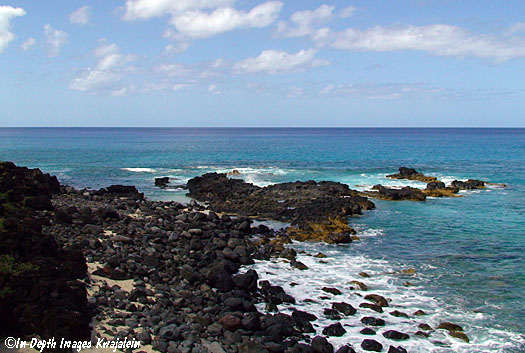
Calling this Makua is a bit of a misnomer. It is really a bit beyond Makua towards Kaena Point. You can get to this site by driving up Farrington Highway northward through Waianae, passing Pokai Bay and past Makaha. Continue on past Makua cave on the right side of the highway and past Makua Ledge, the finger of flat reef that pokes out a hundred feet or so into the ocean just south of Makua Beach. Continue past the end of Makua Beach where the rugged lava coastline starts up again, and drive a few hundred meters more until just before the start of the last big beach before Kaena Point, near the end of the improved road.
The dive site is around the last flow of black basaltic rock the juts out into the ocean, just before the right turn off the highway that would take you past the guard shack and on up the hill to the FPQ14 radar installation on the ridge. There is a small pull-off space on the ocean side of the road where you can park. Beware, though, because this is an area known (or at least, it was in the 1970s and '80s) for car break-ins. I had my driver's side window shattered once by someone who wanted to get at a small tub of loose change I had next to the driver's seat, change that I used in vending machines on the long late ride home after night diving. Let me tell you, it was a cold ride home not having a window to roll up! After that, I left the car unlocked with the windows open, just making sure I did not leave anything inside. If I brought two or three tanks for multiple dives, I'd hide the spares in the rocks and bushes down over the edge of the short cliff that led down to the water. That's also where I hid the distributor wire for my car to make it at least a bit harder for someone to take the whole thing.

This can be a rough area to dive as well. Surf breaking on the rugged lava rocks is pretty intimidating, especially if the surf report for Makaha is 2 feet or higher. So naturally, this is the place I chose as the primary research site for my thesis work. (And here I thought going to the University was supposed to make you smart!) The shot below was still taken on a relatively calm day.
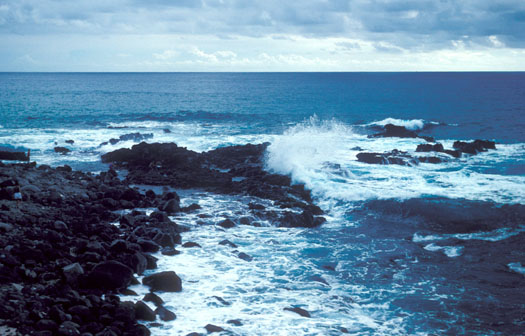
Just on the south side of the last rocky basalt peninsula of rock is a small knee-to-waist-deep cove that is somewhat protected from normal surf conditions. I'd start swimming here, mostly cutting over the surface past and over very shallow rocks through the waves rolling in. Maybe 15 meters or so out the cove, I could finally drop down behind the beginning of the system of outcrops and ledges where I hunted the slugs. The underwater walls extend from 0 to maybe 2 or 3 meters depth at the top, and drop straight down to 4 to 6 meters at the bottom, depending upon where you are along the wall. These short walls are loaded with sponge-encrusted ledges and caves and are a great place for mollusks. The two dead-end coves, however, can get extremely rough, and on a wavy day, it would be easy to get sucked up and over the top of the reef and rolled around on an extremely rough and jagged reeftop covered with long-spined black sea urchins.
Maybe a hundred meters or so south along the coast was another system of underwater ledges similar to these.
Getting back to the entry cove after the dive was the trickiest part of diving this area. Bearing a bit too far left would get you into a different cove, but one that is directly exposed to the surf and is extremely rough. Too far right would put you too close to shore where the waves could roll you over and up onto the boulder beach. It is best to dive this spot a few times during the day to find yourself a pathway of recognizable rocks that will get you in and out of the cove safely.
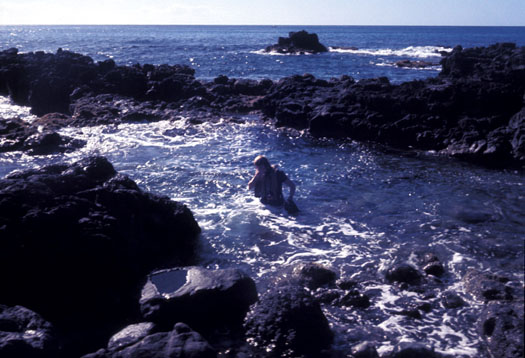
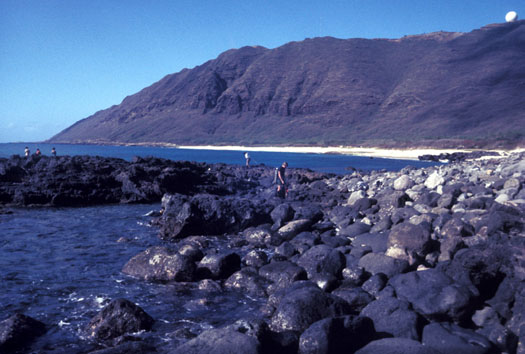
I dove this spot a lot, both day and night, and over time found a good diversity of species. As on many reefs, Glossodoris rufomarginata was by far the most common, followed during the day by Hypselodoris peasei, a species that would all but disappear after dark.
Other spots farther up towards Kaena are probably also good dives, but since the improved road ends, it would be best to go there by boat.
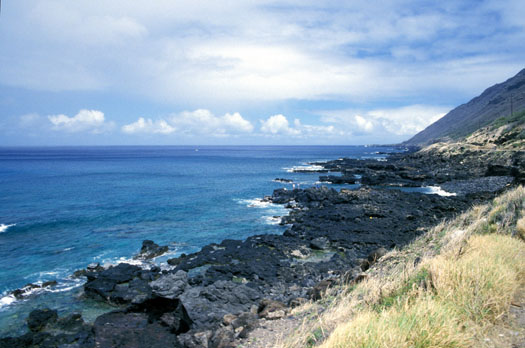
Close tab when finished.